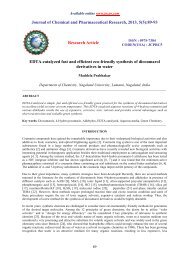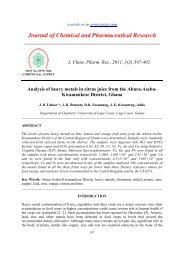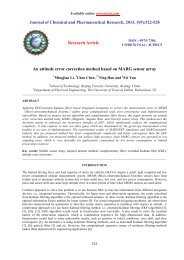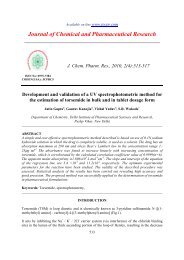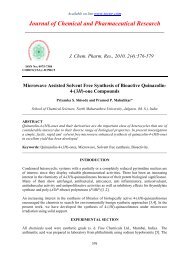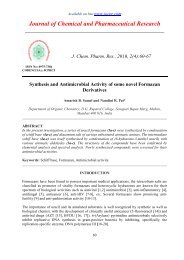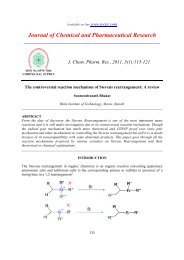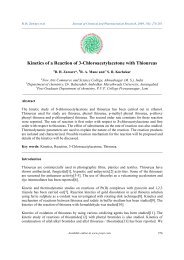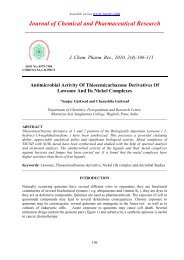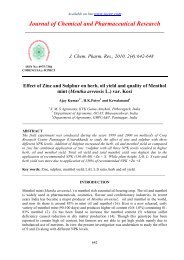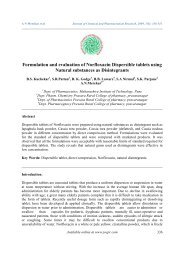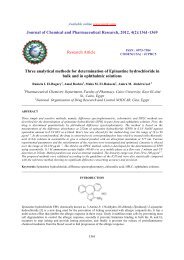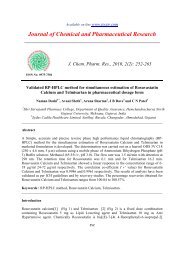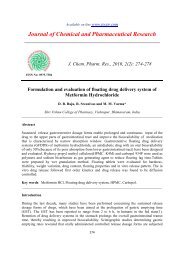Synthesis of some 2-methyl-5-nitroimidazole derivatives - Journal of ...
Synthesis of some 2-methyl-5-nitroimidazole derivatives - Journal of ...
Synthesis of some 2-methyl-5-nitroimidazole derivatives - Journal of ...
Create successful ePaper yourself
Turn your PDF publications into a flip-book with our unique Google optimized e-Paper software.
Available on line www.jocpr.com<br />
<strong>Journal</strong> <strong>of</strong> Chemical and Pharmaceutical Research<br />
__________________________________________________<br />
ISSN No: 0975-7384<br />
CODEN(USA): JCPRC5<br />
J. Chem. Pharm. Res., 2011, 3(1):313-319<br />
<strong>Synthesis</strong> <strong>of</strong> <strong>some</strong> 2-<strong>methyl</strong>-5-<strong>nitroimidazole</strong> <strong>derivatives</strong> as potential<br />
antimicrobial agents<br />
1 Manisha N. Trivedi*, 2 S.Y.Gabhe, 1 Urmila D. Vachhani, 3 Rima Brijesh Patel, 4 Charmi P. Shah<br />
1 Department <strong>of</strong> Analysis, ROFEL, Shri G M Bilakhia College <strong>of</strong> Pharmacy, Vapi, Gujarat, INDIA<br />
2 C.U. Shah College <strong>of</strong> Pharmacy, SNDT University, Santacruz (W), Mumbai, INDIA<br />
3 Quality Assurance Dept., Dr. Reddy's Laboratories, Bachupally, Qutubullar, Hyderabad, A.P., INDIA<br />
4 Department <strong>of</strong> Pharmaceutics, ROFEL, Shri G M Bilakhia College <strong>of</strong> Pharmacy, Namdha Campus,<br />
Vapi, Gujarat, INDIA<br />
_______________________________________________________________________________________________________________<br />
ABSTRACT<br />
The <strong>nitroimidazole</strong> class <strong>of</strong> compounds has yielded several antimicrobial agents that are<br />
currently in use. 5-<strong>nitroimidazole</strong>s are widely used in the treatment <strong>of</strong> diseases caused by<br />
protozoa and anaerobic bacteria. The simplest structural requirement for biological activity is<br />
the 1-alkyl-5-nitro-imidazole unit as exemplified by analogs <strong>of</strong> metronidazole such as tinidazole,<br />
ronidazole, secnidazole, ipronidazole. It has been known that the isopropyl alcoholic functional<br />
group in the secnidazole molecule is suitable for various reactions. Hence it is substituted with<br />
different groups by replacing the hydroxyl group with several groups and other effective<br />
secnidazole <strong>derivatives</strong> were obtained. Using these features, ester <strong>derivatives</strong> <strong>of</strong> 1-(2-<strong>methyl</strong>-5-<br />
nitro-1H-imidazol-1-yl) propan-2-ol were synthesized and their antibacterial and antifungal<br />
activities were assayed.<br />
Key words: secnidazole, <strong>nitroimidazole</strong>, antibacterial and antifungal activity, synthesis.<br />
______________________________________________________________________________<br />
INTRODUCTION<br />
Metronidazole and related N-1 substituted like 5-<strong>nitroimidazole</strong>s ornidazole, secnidazole and<br />
tinidazole are widely used in the treatment <strong>of</strong> diseases caused by protozoa and anaerobic<br />
bacteria[1-3]. For biological activity <strong>of</strong> <strong>nitroimidazole</strong>s, the nitro group in the 5-position <strong>of</strong><br />
imidazole ring is essential and so it has to be sterically unhampered. So the steric protection <strong>of</strong><br />
313
Manisha N. Trivedi et al J. Chem. Pharm. Res., 2011, 3(1):313-319<br />
______________________________________________________________________________<br />
NO 2 group by substituents in positions 1 and 2 appears to be necessary. This configuration not<br />
only influence the metabolism but also physicochemical properties <strong>of</strong> such compounds [4]. Thus<br />
the regions <strong>of</strong> 5-<strong>nitroimidazole</strong> structure involving C 2 , C 5 , and N 1 positions are important in<br />
interaction with receptors in anaerobic organisms. It was shown that a lipophilic NO 2 group may<br />
be important for tissue penetration. Thus the simplest structural requirement for biological<br />
activity is the 1-alkyl-5-nitro-imidazole unit as exemplified by analogs <strong>of</strong> metronidazole such as<br />
tinidazole, ronidazole, secnidazole, ipronidazole [4] . It has been speculated that a reactive<br />
intermediate formed in the microbial reduction <strong>of</strong> the 5-nitro group <strong>of</strong> <strong>nitroimidazole</strong>s covalently<br />
binds to the DNA <strong>of</strong> the microorganism, triggering the lethal effect [5]. The isopropyl alcoholic<br />
functional group in the secnidazole molecule is suitable for various reactions. Hence it is<br />
substituted with different groups by replacing the hydroxyl group with several groups and other<br />
effective secnidazole <strong>derivatives</strong> were obtained. Using these features, ester <strong>derivatives</strong> <strong>of</strong> 1-(2-<br />
<strong>methyl</strong>-5-nitro-1H-imidazol-1-yl) propan-2-ol were synthesized and their antibacterial and<br />
antifungal activities were assayed.<br />
Scheme-I Alcoholysis <strong>of</strong> acyl halides<br />
a or<br />
ROH<br />
R 1 COOH R 1 COCl R 1 COOR<br />
b<br />
Pyridine<br />
a = SOCl 2<br />
R = O N<br />
2 N<br />
b = PCl 5<br />
Compound R 1<br />
A C 17 H 35<br />
B C 15 H 31<br />
C C 13 H 27<br />
D<br />
HOOC<br />
N<br />
OH<br />
NO 2<br />
CH 3<br />
CH 3<br />
E<br />
NO 2<br />
HOOC<br />
F<br />
NO 2<br />
HOOC<br />
NO 2<br />
EXPERIMENTAL SECTION<br />
Drug secnidazole was obtained as gift sample from Cipla Laboratories, Mumbai. Following<br />
chemicals were used for the study: Thionyl chloride, pyridine, benzene sulphonyl chloride, p-<br />
toluene sulphonyl chloride and methanol (Rankem Laboratories, Mumbai), p-nitrobenzoic acid,<br />
3,5-dinitrobenzoic acid, m-nitrobenzoic acid, pthalic acid, 3-nitropthalic acid, stearic acid,<br />
palmitic acid, myristic acid (S.D.Fine-Chem Ltd, Mumbai).<br />
314
Manisha N. Trivedi et al J. Chem. Pharm. Res., 2011, 3(1):313-319<br />
______________________________________________________________________________<br />
<strong>Synthesis</strong> <strong>of</strong> esters<br />
The general schemes for synthesis <strong>of</strong> esters involves reactions between acid chlorides or<br />
anhydrides with alcohol in presence <strong>of</strong> suitable catalyst.<br />
As per scheme-I acid chlorides are prepared by reacting acids with thionyl chloride or<br />
phosphorous pentachloride. These are further reacted with mixture <strong>of</strong> alcohol in presence <strong>of</strong><br />
pyridine, to obtain esters[6-11] .<br />
O<br />
Scheme-II Alcoholysis <strong>of</strong> anhydrides<br />
R 1<br />
O<br />
O<br />
+<br />
ROH<br />
pyridine<br />
∆<br />
R 1<br />
COOH<br />
COOR<br />
`<br />
Compound R 1<br />
G<br />
H<br />
H NO 2<br />
As per scheme-II anhydrides are reacted with alcohol in presence <strong>of</strong> pyridine, reaction mixture is<br />
heated till completion <strong>of</strong> reaction, to obtain the ester[12-15] .<br />
Scheme-III Alcoholysis <strong>of</strong> sulphonyl chlorides<br />
SO 2<br />
Cl<br />
SO 2<br />
OR<br />
pyridine<br />
R 1<br />
+ RO H R 1<br />
∆<br />
+ HC l<br />
Compound R 1<br />
I<br />
H<br />
J CH 3<br />
As per scheme-III alcohol and aromatic substrates like p-toluene sulphonyl chloride, benzene<br />
sulphonyl chloride are refluxed in presence <strong>of</strong> pyridine to obtain ester[16] .<br />
Using these general methods esters <strong>of</strong> secnidazole were synthesized.<br />
Method for antimicrobial activity<br />
The synthesized <strong>derivatives</strong> were analyzed for antimicrobial activity by agar cup plate method.<br />
The organisms used for the antimicrobial study were gram positive organism Staphylococcus<br />
aureus, Bacillus subtilis. The gram negative organisms used for the study were E. coli,<br />
Pseudomonas aeruginosa. The fungi used were Aspergillus niger and Candida albicans. The<br />
concentration <strong>of</strong> synthesized compounds were 100 µg/ml. The standard drugs used for the study<br />
were Streptomycin and Grise<strong>of</strong>ulvin for antibacterial and antifungal activity respectively.<br />
Control test with solvents were performed for every assay but showed no inhibition <strong>of</strong> the<br />
microbial growth. The results are shown in Table 3.<br />
315
Manisha N. Trivedi et al J. Chem. Pharm. Res., 2011, 3(1):313-319<br />
______________________________________________________________________________<br />
All the synthesized compounds were purified by recrystallisation with suitable solvents. The<br />
purity <strong>of</strong> all the synthesized compounds were checked by their melting point and thin layer<br />
chromatographic pattern. The melting points were determined in open capillaries by using Expo-<br />
HiTech melting point apparatus. The Rf values were found out by thin layer chromatography<br />
using precoated silica gel G plates as stationary phase and a suitable mobile phase. Detection was<br />
done by exposure to UV radiation and iodine vapours. The structures <strong>of</strong> synthesized compounds<br />
were characterized by their infrared spectra using Jasco FTIR-4100 and Jasco FTIR-5300. Mull<br />
method and KBr disc method was used to record IR spectra. The structures <strong>of</strong> synthesized<br />
compounds were characterized and confirmed by recording their NMR spectra using VNMRS-<br />
300 spectrometer, 300MHz. Deuteriated chlor<strong>of</strong>orm carbon tetrachloride and di<strong>methyl</strong><br />
sulphoxide were the solvents used for recording NMR spectra. Tetra<strong>methyl</strong> silane was used as<br />
the reference standard. The structures <strong>of</strong> <strong>some</strong> synthesized compounds were also confirmed by<br />
Mass spectrum analysis. Table 1 and 2<br />
<strong>Synthesis</strong> <strong>of</strong> 1-<strong>methyl</strong>-2-(2-<strong>methyl</strong>-5-nitro-1H-imidazol-1-yl)ethyl octadecanoate (Compound A)<br />
Mixture <strong>of</strong> Stearic acid (1g, 3.52 mmoles) and thionyl chloride (0.5ml, 6.87 mmoles) was<br />
refluxed at 65 o C for one hour by placing calcium chloride guard tube on reflux condenser to<br />
absorb the hydrogen chloride gas formed during reaction. Stearoyl chloride thus formed was<br />
highly fuming and immediately reacted with mixture <strong>of</strong> secnidazole (1g, 5.4 mmoles) and<br />
pyridine (0.5ml, 6.20mmoles). The reaction beaker was intermediately kept on ice bath to cool<br />
the beaker heated by reaction between stearoyl chloride, secnidazole and pyridine. The solid<br />
separated after stirring for 5-10 minutes was cooled and recrystallised using hot methanol.<br />
<strong>Synthesis</strong> <strong>of</strong> 1-<strong>methyl</strong>-2-(2-<strong>methyl</strong>-5-nitro-1H imidazol-1-yl) ethyl hexadecanoate (Compound<br />
B) and <strong>Synthesis</strong> <strong>of</strong> 1-<strong>methyl</strong>-2-(2-<strong>methyl</strong>-5-nitro-1H-imidazol-1-yl) ethyl tetradecanoate<br />
(Compound C) were carried out in similar manner.<br />
<strong>Synthesis</strong> <strong>of</strong> 1-<strong>methyl</strong>-2-(2-<strong>methyl</strong>-5-nitro-1H imidazol-1-yl) ethyl 4-nitrobenzoate (Compound D)<br />
Mixture <strong>of</strong> p-Nitrobenzoic acid (1.0g, 6mmoles) and phosphorous pentachloride (1.3g, 6mmoles)<br />
was refluxed at 70 o C for one hour by placing calcium chloride guard tube on reflux condenser to<br />
absorb the hydrogen chloride gas formed during reaction. A pale yellow homogenous liquid <strong>of</strong> p-<br />
Nitrobenzoyl chloride which solidifies and separates as fine yellow needles melting at 71-73 o C<br />
was immediately reacted with mixture <strong>of</strong> secnidazole (1g, 5.4 mmoles) and pyridine (0.8ml,<br />
10mmoles). The reaction beaker was intermediately kept on ice bath to cool the beaker heated<br />
by reaction between p-Nitrobenzoyl chloride, secnidazole and pyridine. After completion <strong>of</strong><br />
reaction 10-15ml <strong>of</strong> 2% sodium hydrogen carbonate solution was added to the reaction mixture<br />
and solid thus separated was washed with water, filtered and dried. Recrystallised using hot<br />
methanol giving yellow colored crystals.<br />
<strong>Synthesis</strong> <strong>of</strong> 1-<strong>methyl</strong>-2-(2-<strong>methyl</strong>-5-nitro-1H-imidazol-1-yl) ethyl 3-nitrobenzoate (Compound<br />
E) and <strong>Synthesis</strong> <strong>of</strong> 1-(2-<strong>methyl</strong>-5-nitro-1H-imidazol-1-yl)propan-2-yl 3,5-dinitrobenzoate<br />
(Compound F) were carried out in similar manner.<br />
<strong>Synthesis</strong> <strong>of</strong> 2-{[1-<strong>methyl</strong>-2-(2-<strong>methyl</strong>-5-nitro-1H-imidazol-1yl)ethoxy]carbonyl}benzoic acid<br />
(Compound G)<br />
Mixture <strong>of</strong> Secnidazole (1.0g, 5.4mmoles) and pyridine (1.0ml, 12.4mmoles) were placed in<br />
porcelain dish and stirred on water bath to dissolve secnidazole. To it phthalic anhydride (1.0g,<br />
316
Manisha N. Trivedi et al J. Chem. Pharm. Res., 2011, 3(1):313-319<br />
______________________________________________________________________________<br />
6.75mmoles) was added slowly with constant stirring and heating on water bath maintained at<br />
100 o C. When phthalic anhydride dissolves completely, it was cooled and to it 5-10ml hot water<br />
was added , stirred and allowed to cool. Crude product was washed with water, dried and<br />
recrystallised from hot water.<br />
Table 1: Physical data <strong>of</strong> synthesized compounds<br />
Compd MF % Yield M P o C MW R f value Solubility<br />
Elemental Analysis<br />
%C %H %N %O %S<br />
A C 25 H 45 N 3 O 4 78.19 46-47 451.643 0.51* a,b,c,d,e 66.48 10.02 9.30 14.15 -<br />
B C 23 H 41 N 3 O 4 84.21 45-47 423.589 0.56* a,b,c 1 ,d,e 65.21 9.76 9.90 15.10 -<br />
C C 21 H 37 N 3 O 4 75.24 42-44 395.538 0.53* a,b,c 1 ,d,e 63.77 9.43 10.60 16.15 -<br />
D C 14 H 14 N 4 O 6 91.67 161-163 334.285 0.46* a,b,c,d,e 50.28 4.22 16.75 28.72 -<br />
E C 14 H 14 N 4 O 6 68.76 126-128 334.285 0.44* a,b,c,d,e 50.30 4.22 16.76 28.70 -<br />
F C 14 H 13 N 5 O 8 78.81 152-154 379.283 0.47* a,b,c,d,e 44.32 3.45 18.45 33.74 -<br />
G C 15 H 15 N 3 O 6 83.88 197-199 333.296 0.69** d,e 54.05 4.53 12.60 28.80 -<br />
H C 15 H 14 N 4 O 8 85.27 233-235 378.294 0.52** d,e 47.62 3.72 14.80 33.84 -<br />
I C 13 H 15 N 3 O 5 S 75.80 131-133 325.340 0.41* a,b,c,d,e 47.97 4.65 12.92 24.59 9.85<br />
J C 14 H 17 N 3 O 5 S 81.96 133-136 339.367 0.42* a,b,c,d,e 49.55 5.05 12.38 23.57 9.45<br />
* Toluene: Glacial acetic acid (8:2), * * Chlor<strong>of</strong>orm: Hexane: Ethanol (8:1.5:0.5), a – Methanol, b- Ethanol, c-<br />
Chlor<strong>of</strong>orm, d- DMSO, e- DMF, 1- Slightly soluble<br />
Table 2 : Infrared /H 1 NMR/ MS data <strong>of</strong> synthesized compounds<br />
Compd IR wavenumbers cm -1 NMR protons (δ ppm) m/z<br />
2.52 (s, 3H, CH<br />
2916, 2851 (C-H), 1736 (C=O), 1541 (NO<br />
A<br />
2 ),<br />
3 ), 5.2-5.3 (m, 1H, CH),<br />
4.62 (d, 2H, CH<br />
1471 (CH 3 ), 1267 (C-N), 1170, 1194 (C- O)<br />
2 ), 1.3 (d, 3H, CH 3 ), 7.95<br />
(s, 1H, Ar-CH), 1.2-1.4 (m, 35H, C 17 H 35 )<br />
B<br />
C<br />
D<br />
E<br />
F<br />
G<br />
H<br />
2916, 2851 (C-H), 1736 (C=O), 1541 (NO 2 ),<br />
1471 (CH 3 ), 1267(C-N), 1194 (C-O)<br />
2918, 2851 (C-H), 1739 (C=O), 1541 (NO 2 ),<br />
1471 (CH 3 ), 1267 (C-N), 1107, 1194 (C-O)<br />
3072 ( Ar C-H ), 1718 (C=O), 1601(C=C),<br />
1523 (NO 2 ), 1461 (CH 3 ), 1274 (C-N),<br />
1103, 1191 (C-O)<br />
3087 (Ar C-H), 1718 (C=O), 1614 (C=C),<br />
1524 (NO 2 ), 1461 (CH 3 ), 1277 (C-N), 1073,<br />
1186 (C-O),<br />
3099 (Ar C-H) ,1731 (C=O), 1544 (NO 2 )<br />
1282 (C-N) 1077, 1194 cm -1 (C-O)<br />
3425 (OH), 2923 (C-H ), 1730 (C=O), 1542<br />
(NO 2 ), 1465 (CH 3 ), 1268 (C-N),1076,<br />
1195 (C-O)<br />
3448 (O-H), 2923 (C-H ), 1730 (C=O), 1524<br />
(NO 2 ), 1465 (CH 3 ), 1268 (C-N), 1075,1191<br />
(C-O)<br />
317<br />
1.28 (d, 3H, CH 3 ), 2.46 (s, 3H, CH 3 ), 4.53<br />
(d, 2H, CH 2 ), 5.15-5.18 (m, H, CH), 7.85<br />
(s, 1H, Ar-CH), 1.18-1.29<br />
(m,31H,C 15 H 31 )<br />
1.01-1.12 (m, 23H, C 13 H 23 ), 2.18-2.21 (t,<br />
2H, CH 2 ), 1.41 (d, 3H, CH 3 ), 2.48 (s, 3H,<br />
CH 3 ), 4.37 (d, 2H, CH 2 ), 5.0 (m, 1H,<br />
CH), 7.88 (s,1H, Ar-H)<br />
2.48 (s, 3H, CH 3 ), 1.58 (d, 3H, CH)<br />
4.65 (d, 2H, CH 2 ), 5.3-5.6 ( m, 1H, CH)<br />
7.9-8.3 (m, 5H, Ar C-H)<br />
1.56 (d, 3H, CH 3 ), 2.5 (s, 3H, CH 3 )<br />
4.7 (d, 2H, CH 2 ), 5.58-6.2 (m, H, CH)<br />
7.6-8.8 (m, 5H, Ar C-H).<br />
1.45 (d, 3H, CH 3 ), 2.50 (s, 3H, CH 3 ),<br />
4.70 (d, 2H, CH 2 ), 5.42-5.5 (m, H, CH),<br />
8.0-8.78 (m,4H, Ar-H).<br />
2.30 ( s, 3H, CH 3 ), 1.40 ( d, 3H, CH 3 )<br />
4.62 ( d, 2H, CH 2 ), 5.3-5.5 ( m, 1H, CH)<br />
7.2-8.1 ( m, 5H, Ar C-H), 13.3 (s, 1H,<br />
COOH)<br />
1.45 (d, 3H, CH 3 ), 2.50 (s, 3H, CH 3 )<br />
4.7 (d, 2H, CH 2 ), 5.4-5.6 (m, 1H, CH),8.0<br />
– 8.78 (m,4H,Ar C-H), 13.28 (s,1H,<br />
COOH)<br />
-<br />
-<br />
334.9<br />
(M+1)<br />
208,149.9<br />
334 (M+1)<br />
208, 150<br />
379 (M +1)<br />
253, 168<br />
333.9<br />
(M+1)<br />
207,149<br />
379 (M +1)<br />
252, 194,<br />
168.
Manisha N. Trivedi et al J. Chem. Pharm. Res., 2011, 3(1):313-319<br />
______________________________________________________________________________<br />
I<br />
J<br />
3096 (ArC-H), 2962, 2923 (C-H) 1525 (NO 2 ),<br />
1461(CH 3 ), 1363 (S=O 2 , Asym), 1263 (C-N),<br />
1190 (S=O 2 Sym),<br />
3078 (ArC-H), 2955, 2918 (C-H), 1527<br />
(NO 2 ), 1462 (CH 3 ), 1376, (S=O 2 Asym), 1263<br />
(C-N),1175 (S=O 2 Sym)<br />
1.52 (d, 3H, CH 3 ), 2.48 (s, 3H, CH 3 )<br />
4.5 (d, 2H, CH 2 ), 4.8-4.9 (m, 1H, CH)<br />
7.4-7.65 (m, 5H, Ar- H)<br />
1.52 (d, 3H, CH 3 ), 2.42 (s, 3H, CH 3 )<br />
4.45 (d, 2H, CH 2 ), 4.76-4.88 (m, 1H, CH)<br />
7.18-7.60 (m, 5H, Ar-CH)<br />
-<br />
339.9<br />
(M+1)<br />
168<br />
Table 3 : antibacterial and antifungal activity <strong>of</strong> synthesized compounds<br />
Compound<br />
Zone <strong>of</strong> inhibition in mm at 100µg/ml<br />
S. aureus B. subtilis E. coli P. aeruginosa A. niger C. albicans<br />
A 23 23 21 22 20 21<br />
B 23 20 23 19 21 19<br />
C 18 17 19 18 12 14<br />
D 22 20 23 20 20 19<br />
E 23 22 23 21 14 15<br />
F 24 20 22 22 13 15<br />
G 14 16 17 18 15 17<br />
H 16 15 13 15 14 18<br />
I 24 22 20 21 21 20<br />
J 23 24 21 22 20 21<br />
Secnidazole 22 21 21 22 18 19<br />
Ampicillin 23 23 22 21 - -<br />
Grise<strong>of</strong>ulvin - - - - 23 23<br />
* Including diameter <strong>of</strong> the well 12 mm<br />
<strong>Synthesis</strong> <strong>of</strong> 2-{[1-<strong>methyl</strong>-2-(2-<strong>methyl</strong>-5-nitro-1H-imidazol-1-yl) ethoxy] carbonyl}-3-nitrobenzoic<br />
acid (Compound H)<br />
First 3-nitrophthalic anhydride was synthesized by refluxing a mixture <strong>of</strong> 3-nirtophthalic acid<br />
(2.5 g 11.8 mmoles) and acetic anhydride (2.48 g, 24.3 mmoles) for one hour at 80˚C. The hot<br />
mixture was poured in porcelain dish, allowed to cool and crystallize. The crystals <strong>of</strong> 3-<br />
nitrophthalic anhydride were grinded in mortar with 15 ml <strong>of</strong> sodium dried ether. The product<br />
was filtered, once more washed with 15 ml <strong>of</strong> ether and dried and used for synthesis <strong>of</strong> ester in<br />
manner similar to compound G.<br />
<strong>Synthesis</strong> <strong>of</strong> 1-<strong>methyl</strong>-2-(2-<strong>methyl</strong>-5-nitro-1H-imidazol-1-yl) ethyl benzenesulfonate (Compound I)<br />
Mixture <strong>of</strong> Secnidazole (1 g, 5.4 mmoles), pyridine (1.0ml, 12.4 mmoles) and benzenesulfonyl<br />
chloride (2 gm, 11.3 mmoles) was refluxed at 60˚C for one hour. The reaction mixture was<br />
poured into 25 ml cold 2% sodium bicarbonate solution and stirred vigorously until the oil<br />
solidifies. The crude product was recrystallized from methanol.<br />
<strong>Synthesis</strong> <strong>of</strong> l-(2-<strong>methyl</strong>-5-nitro-1H imidazol-1-yl) ethyl-4-<strong>methyl</strong>benzenesulfonate (Compound<br />
J) was in similar manner.<br />
RESULTS AND DISCUSSION<br />
Ester <strong>derivatives</strong> <strong>of</strong> 1-(2-<strong>methyl</strong>-5-nitro-1H-imidazol-1-yl) propan-2-ol were synthesized and the<br />
structures <strong>of</strong> the compounds were established by means <strong>of</strong> IR, 1 H-NMR, MS and elemental<br />
analysis. All the compounds were evaluated for antibacterial and antifungal activity by cup-plate<br />
method. Compounds A, B, D, E, F, I and J have shown significant antibacterial activity.<br />
Remaining compounds have also shown moderate or weak antibacterial activity. Compounds A,<br />
318
Manisha N. Trivedi et al J. Chem. Pharm. Res., 2011, 3(1):313-319<br />
______________________________________________________________________________<br />
B, D, I and J have shown significant antifungal activity. Remaining compounds have also shown<br />
moderate or weak antifungal activity. The synthesized compounds are novel molecules and can<br />
prove as potent antimicrobial agents in future.<br />
Acknowledgements<br />
The authors are thankful to Principal, C.U.Shah College <strong>of</strong> Pharmacy, S.N.D.T womens<br />
University, Mumbai, for providing necessary facilities to carry out the work. Cipla Laboratories<br />
Ltd. Mumbai for providing gift sample <strong>of</strong> Secnidazole, Dr. Smita Kavishwar, Centaur House,<br />
Mumbai, Pr<strong>of</strong>. Akamanchi K.G, Head <strong>of</strong> Pharmacy Division, UICT and Dr. Venkat Manohar,<br />
Nicholas Piramal Research Centre, Mumbai for helping with spectral analysis <strong>of</strong> compounds.<br />
REFERENCES<br />
[1] M. Bock; Arzneim. Forsch. Drug Res., 1961, 11, 587–590.<br />
[2] M. H<strong>of</strong>fer; E. Grunberg. J.Med. Chem., 1974, 17, 1019–1020.<br />
[3] S.C. Bhatia; V.D. Shanbhag., J. Chromatogr. 1984, 3, 305, 325–334.<br />
[4] W Raether; H Hanel. Parisitol Research, 2003, 90, S19-S39.<br />
[5] N Silvia; J.Moreno; R Docampo. Enviornmental Health Perspectives., 1985, 64, 199-208<br />
[6] BS Furniss; AJ Hannaford; PWG Smith; AR Tatchell. Vogels Textbook <strong>of</strong> Practical Organic<br />
Chemistry; fifth edition, Longman Singapore publishers, Singapore, 1989, 1241-43, 1344-60.<br />
[7] RT Morison; RN Boyd. Organic Chemistry; sixth edition, Prentice Hall <strong>of</strong> India Pvt. Ltd,<br />
New Delhi, 2000, 737-39.<br />
[8] S Patai. Chemistry <strong>of</strong> Acid Derivatives, John Wiley & Sons, New York 1979, 1, 411-36.<br />
[9] S Patai. The Chemistry <strong>of</strong> Carboxylic Acids and Esters, John Wiley & Sons, New York,<br />
1969, 390-91,513.<br />
[10] MA Ogharuso; JF Wolfe. <strong>Synthesis</strong> <strong>of</strong> Carboxylic Acid Esters & their Derivatives, John<br />
Wiley & Sons, New York, 1991, 684.<br />
[11] Shriner; Herman; Morrill; Curtin; Fuson. The Systemic Identification <strong>of</strong> Organic<br />
Compounds, eighth edition, John Wiley & Sons, New York, 2004, 367-69.<br />
[12] Organic <strong>Synthesis</strong>, Collective 1941, 1, 394, 1923, (3), 375.<br />
[13] Ullmann’s Encyclopedia <strong>of</strong> Industrial Chemistry, Wiley VCH-01, New York, 1989,7, 657-<br />
59,<br />
[14] Ullmann’s Encyclopedia <strong>of</strong> Industrial Chemistry, Wiley VCH-01, New York, 1989, 12,<br />
305-26<br />
[15] Ullmann’s Encyclopedia <strong>of</strong> Industrial Chemistry, Wiley VCH-01, New York, 1989, A3,<br />
555-69.<br />
[16] JM Coxon. Advances in Detailed Reaction Mechanisms, Reactions <strong>of</strong> importance in<br />
synthesis, Greenwich, Jai Press, New Delhi, 1994, 3, 289.<br />
319



